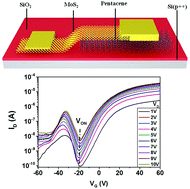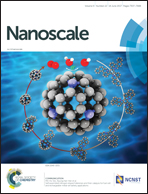Configuration-dependent anti-ambipolar van der Waals p–n heterostructures based on pentacene single crystal and MoS2†
Abstract
Recently, van der Waals heterostructures (vdWHs) have trigged intensive interest due to their novel electronic and optoelectronic properties. The vdWHs could be achieved by stacking two dimensional layered materials (2DLMs) on top of another and vertically kept by van der Waals forces. Furthermore, organic semiconductors are also known to interact via van der Waals forces, which offer an alternative for the fabrication of organic–inorganic p–n vdWHs. However, the performances of organic–inorganic p–n vdWHs produced so far are rather poor, owing to the unmatched electrical property between the 2DLMs and organic polycrystalline films. To make improvements in such novel heterostructure architectures, here we adopt high quality organic single crystals instead of polycrystalline films to construct a pentacene/MoS2 p–n vdWH. The vdWHs show a much higher current density and better anti-ambipolar characteristics with a highest transconductance of 211 nS. Moreover, device configuration-dependent transfer characteristics are demonstrated and a mechanism of a gate bias modulated vertical space charge zone existing at the vertical p–n vdWHs interface is proposed. These findings provide a new route to optimize the organic–inorganic p–n vdWHs and a guideline for studying the intrinsic properties of vdWHs.

- This article is part of the themed collection: Editor’s Choice: van der Waals heterostructures


 Please wait while we load your content...
Please wait while we load your content...